How TrickBot Hooking Engine Targets Windows 10 Browsers
The Zero2Hero malware course continues with Vitali Kremez revealing how TrickBot’s hooking engine targets Chrome, Firefox, Explorer and Edge in Windows 10

Background & Summary
TrickBot banking malware remains one of the more interesting and continually developing malware on the financial crimeware landscape. It employs multiple means and methods to exploit compromised machines of interest. The focus of this post is to cover in-depth some of its Windows 10 Microsoft Edge and other browser hooking engine functionality. We will focus on the internals, and how TrickBot leverages these browsers to set up hooks for API calls of interest. The ultimate goal of the malware browser hooking is predominantly to intercept online banking credentials before they become SSL encrypted. The stolen credentials can subsequently be used for account takeover (ATO) fraud.
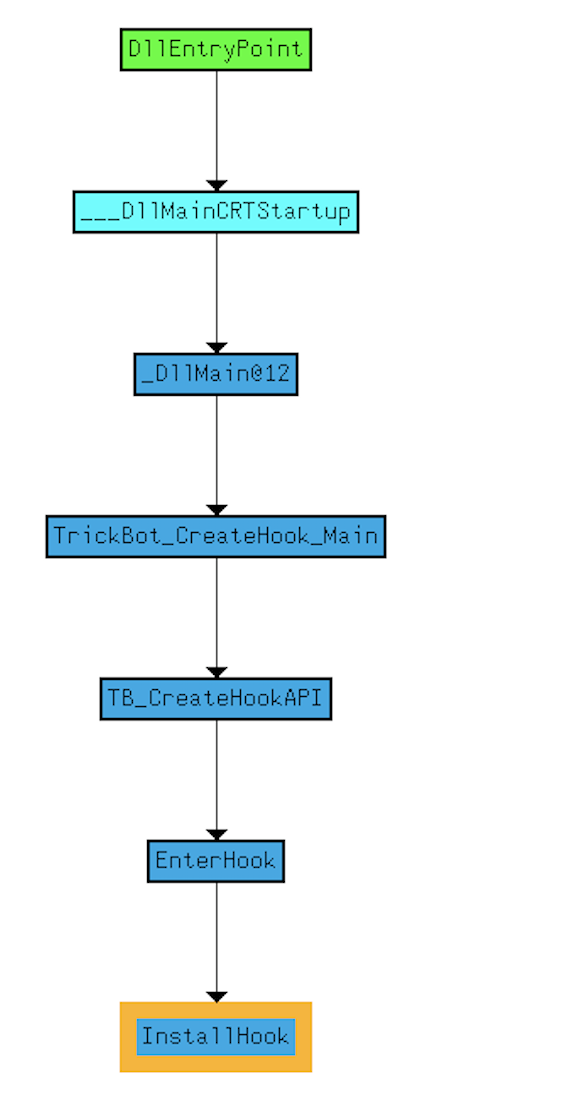
Since Windows 10 came with a new browser, “Microsoft Edge”, TrickBot operators needed their banking malware to operate on that software. To implement form-grabbing and web injections in the Windows 10 Edge browser, TrickBot’s rogue rtlbroker hooks the microsoftedgecp.exe process. Normally, runtimebroker.exe is the parent process of the Microsoft Edge browser on Windows 10 machines.
TrickBot Browser Process Injection Technique “Reflective Loader”
In order to hook browser functions, TrickBot malware injects the payload into the browser of choice via the so-called “ReflectiveLoader” methodology.
The TrickBot process injection function targets four browsers from Microsoft Edge to Google Chrome and one Microsoft Edge related process.
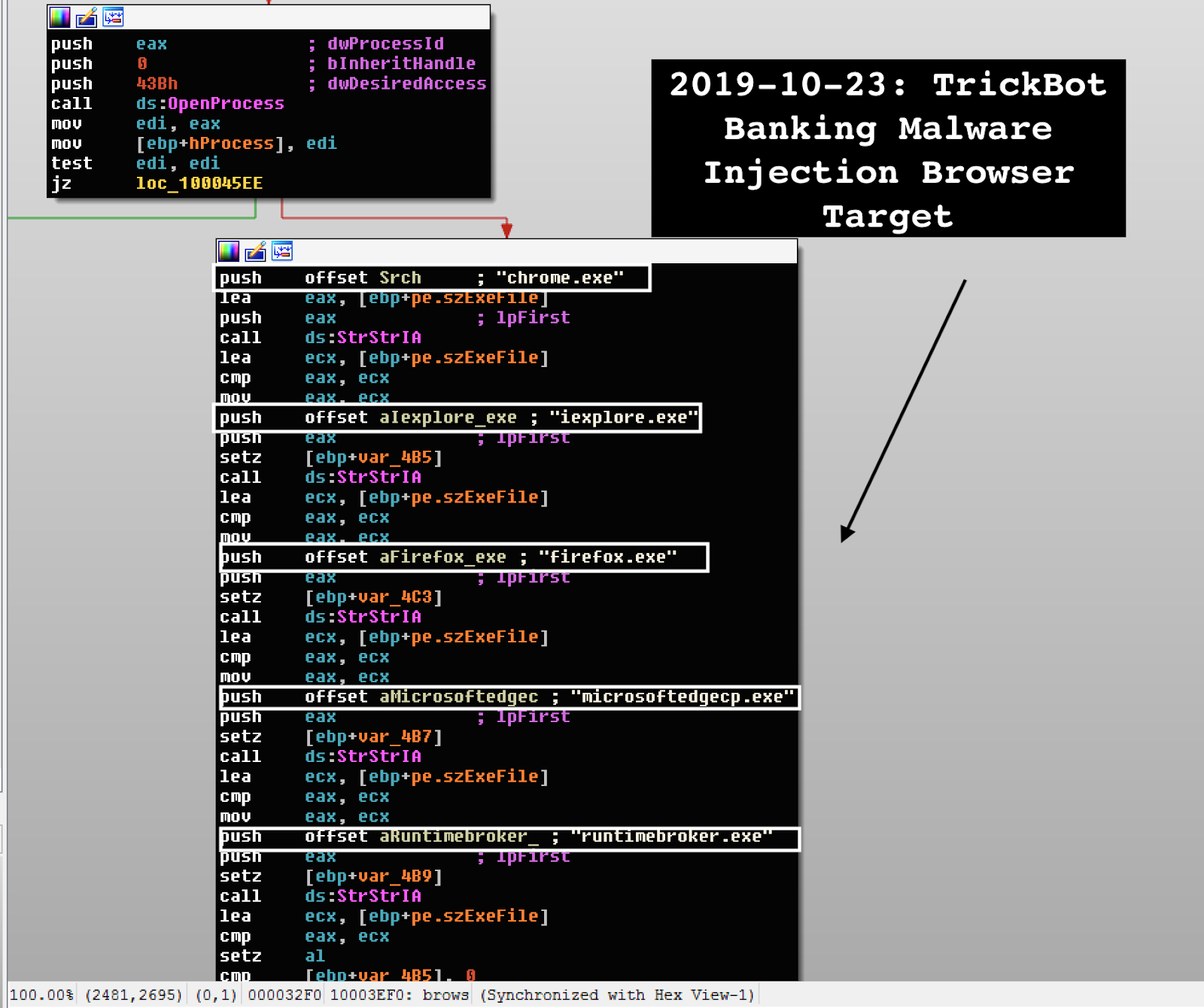
TrickBot injects the malware targeting the following processes:
- chrome.exe
- iexplore.exe
- firefox.exe
- microsoftedgecp.exe
- runtimebroker.exe
The malware also “relaxes” browser security and write changes files locally before injection occurs.
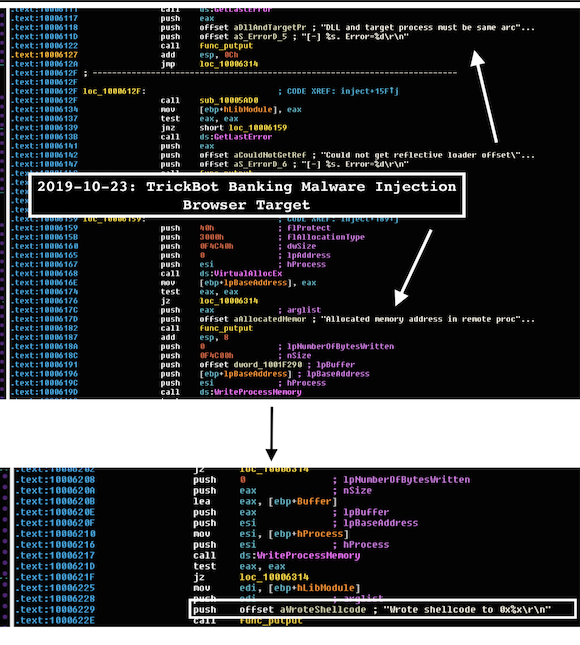
TrickBot’s reflective injection works as follows:
- Open target process and allocate memory address in remote process via
VirtualAllocEx - Copy function
WriteProcessMemoryinto the allocated memory space - Copy shellcode
WriteProcessMemoryinto the allocated memory space - Call
FlushInstructionCacheAPI to make sure our changes are written right away - Call inject
RemoteThreadfunction call - Call
ResumeThread - Else, call undocumented API function
RtlCreateUserThreadto start execution in the remote process, using the offset address of the reflective loader function as the entry point.
TrickBot Hooking Engine
When the TrickBot banker hooks the API function, it enters the new hooked one and checks to make sure the process is microsoftedgecp.exe while passing control to the original one when the hooked function concludes.
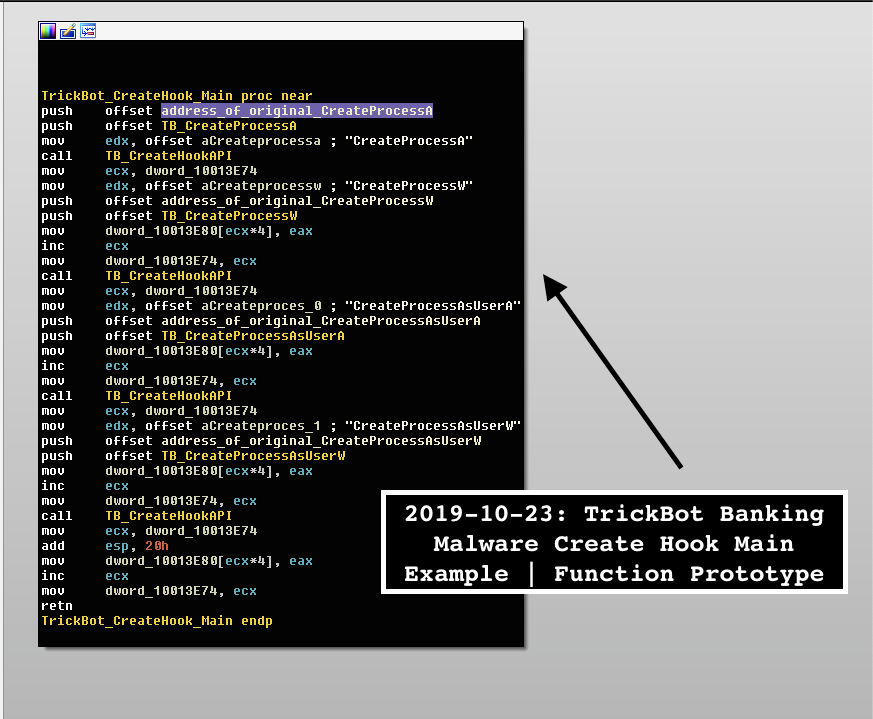
The basic TrickBot banking API hooking template is as follows:
"CreateHook_API" Function Template -> { int CreateHook_API(LPCSTR DLL_name, int original_function_name, int myHook_function, int address_of_original_function) }
By and large, TrickBot hooking engine works via overwriting the basic API with the redirect functions with the 0xe9 opcode, which is the call for a jump with 32-bit relative offset. TrickBot uses a trampoline function and the write hook call with the VirtualProtectEx API to make sure that the function has the 0x40 (PAGE_EXECUTE_READWRITE) property. Additionally, it attempts to conceal detection of this hooking technique via prepending NOP and/or RETN.
The exact TrickBot hook pseudo-code is as follows:
//////////////////////////////////////////////////////////////////// /////////////// TrickBot Hook Install Function /////////////////////// /////////////////////////////////////////////////////////////////// signed int __cdecl TrickBot_Hook_Install(int myHook_function, int *function_address) { char *original_function; char *current_func_id_thread; int v5; char jump_len; signed int result; SIZE_T v8; void *trampoline_lpvoid; int v10; int v11; unsigned __int8 jmp_32_bit_relative_offset_opcode; int relative_offset; DWORD flOldProtect; original_function = func_name; current_func_id_thread = func_name + 0x24; iter_func(func_name + 0x24, 0x90, 0x23); if ( function_address ) // Attempts to prepend "0x90" (nop) or "0xC3" (retn) to jump length to avoid basic hooking detect jump_len = walker_byte_0(*(_BYTE **)(original_function + 1), (int)current_func_id_thread, v5); else jump_len = 5; // jump_length_trampoline -> 5 original_function[5] = jump_len; if ( !jump_len ) goto LABEL_12; // Setting up the trampoline buffer write_hook_iter((int)(original_function + 6), *(_BYTE **)(original_function + 1), (unsigned __int8)jump_len); if ( function_address ) *function_address = (int)current_func_id_thread; relative_offset = myHook_function - *(_DWORD *)(original_function + 1) - 5; v8 = (unsigned __int8)original_function[5]; trampoline_lpvoid = *(void **)(original_function + 1); jmp_32_bit_relative_offset_opcode = 0xE9u; // "0xE9" -> opcode for a jump with a 32bit relative offset if ( VirtualProtectEx((HANDLE)0xFFFFFFFF, trampoline_lpvoid, v8, 0x40u, &flOldProtect) ) // Set up the function for "PAGE_EXECUTE_READWRITE" w/ VirtualProtectEx { v10 = *(_DWORD *)(original_function + 1); v11 = (unsigned __int8)original_function[5] - (_DWORD)original_function - 0x47; original_function[66] = 0xE9u; *(_DWORD *)(original_function + 0x43) = v10 + v11; write_hook_iter(v10, &jmp_32_bit_relative_offset_opcode, 5); // -> Manually write the hook VirtualProtectEx( // Return to original protect state (HANDLE)0xFFFFFFFF, *(LPVOID *)(original_function + 1), (unsigned __int8)original_function[5], flOldProtect, &flOldProtect); result = 1;
For instance, TrickBot malware sets up its own custom myCreateProcessA function prototype after the hook on CreateProcessA. The idea is to catch any instance of microsoftedgecp.exe execution to intercept it for subsequent injection. This function ultimately returns the flow back to CreateProcessA after intercepting and collecting necessary process execution information.
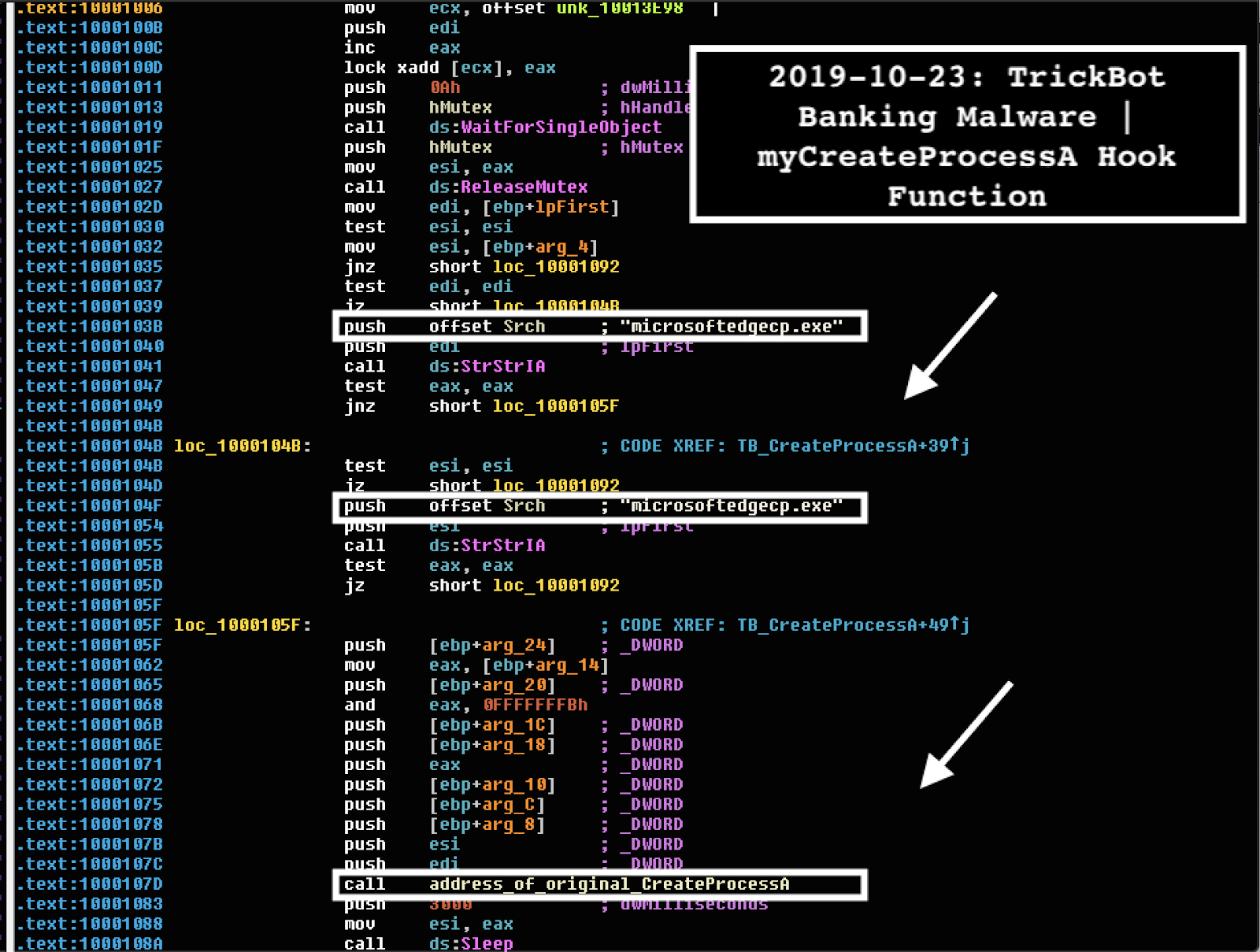
The following four API calls being hooked are in the child Microsoft Edge via rogue rtlbroker.dll, allowing TrickBot operators to intercept and manipulate Microsoft Edge calls:
- CreateProcess
- CreateProcessW
- CreateProcessAsUserA
- CreateProcessAsUserW
TrickBot hooks Internet Explorer and Microsoft Edge in wininet.dll library API calls:
- HttpSendRequestA
- HttpSendRequestW
- HttpSendRequestExA
- HttpSendRequestExW
- InternetCloseHandle
- InternetReadFile
- InternetReadFileExA
- InternetQueryDataAvailable
- HttpQueryInfoA
- InternetWriteFile
- HttpEndRequestA
- HttpEndRequestW
- InternetQueryOptionA
- InternetQueryOptionW
- InternetSetOptionA
- InternetSetOptionW
- HttpOpenRequestA
- HttpOpenRequestW
- InternetConnectA
- InternetConnectW
The malware hooks Mozilla Firefox Browser in nspr4.dll library API calls:
- PR_OpenTCPSocket
- PR_Connect
- PR_Close
- PR_Write
- PR_Read
It hooks Chrome in chrome.dll library API calls:
- ssl_read
- ssl_write
Reference
| injectDll32.dll | C546D40D411D0F0BB7A1C9986878F231342CDF8B |
| rtlbrokerDll.dll | 0785D0C5600D9C096B75CC4465BE79D456F60594 |
| testnewinj32Dll.dll | D5F98BFF5E33A86B213E05344BD402350FC5F7CD |
Like this article? Follow us on LinkedIn, Twitter, YouTube or Facebook to see the content we post.
Read more about Cyber Security
- Zero2Hero Previous: Writing Malware Traffic Decrypters for ISFB/Ursnif
- 7 Lessons Every CISO Can Learn From the ANU Cyber Attack
- Behind Enemy Lines | Looking into Ransomware as a Service (Project Root)
- APT and the Enterprise – FUD or Real Threat?
- Writing Malware Traffic Decrypters for ISFB/Ursnif
- <a href="https://www.sentinelone.com/b
log/cyber-insurance-is-no-substitute-for-robust-cybersecurity-systems/” target=”_blank” rel=”noopener noreferrer”>Cyber Insurance Is No Substitute For Robust Cybersecurity Systems




Leave a Reply
Want to join the discussion?Feel free to contribute!